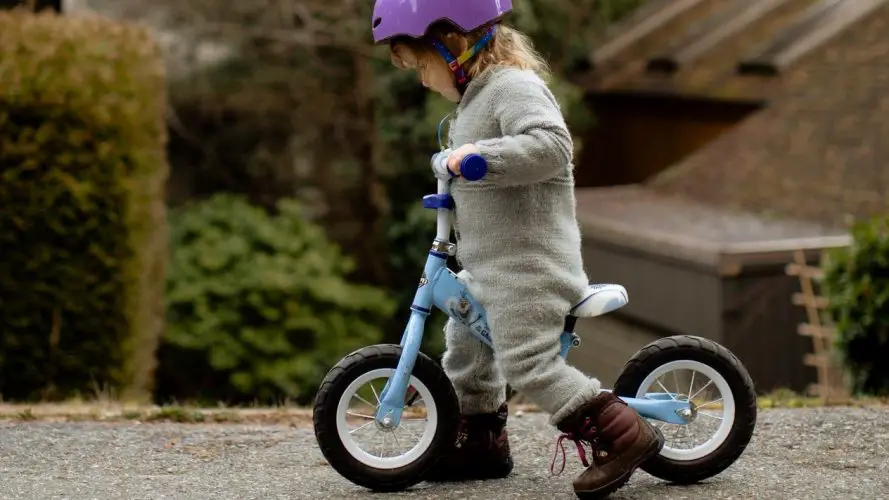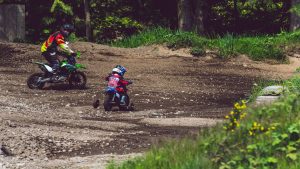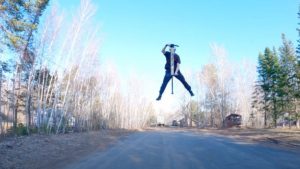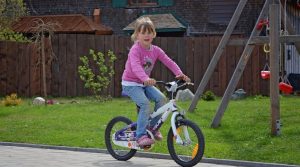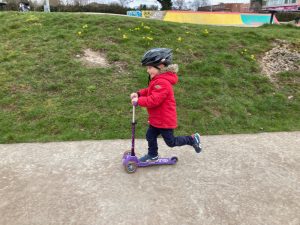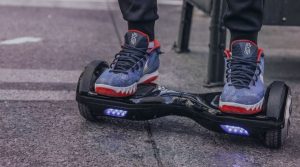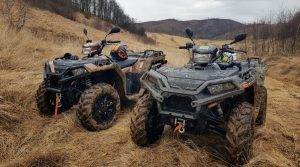Balance bikes are fast replacing training wheels for toddlers learning how to ride a bike. Parents and experts alike have found that when children learn on a balance bike, it generally makes for a smoother transition to a two-wheeler.
They use their feet to propel forward, gliding and balancing, resulting in fewer falls and accidents. Once they can confidently balance, learning how to use pedals is a breeze.
Maybe you already know this but have no idea how to actually choose a balance bike. Lucky for you, we’ve put together a guide so that they’ll be cruising in no time.
Related: How to Teach Your Child to Ride a Balance Bike: A Simple Guide
What to consider when choosing a balance bike
We get it, you’re currently lost in a sea of balance bikes and ready to order the next one you see just so you can stop reading reviews. If you’re ready to make your purchase, you can check out our carefully curated list of the best balance bikes for toddlers.
If you’d like to do a little research first, we promise to make it as painless as possible.
1.The size of the bike
Balance bikes come in a variety of sizes, just like toddlers, which means that taking the time to measure and figure out the right size for your child can make all the difference. Have you ever tried to ride a bike that is too big or too small for you? It makes the task nearly impossible, and the same will be true for your toddler. Above all else, choosing the right-size balance bike for your child is the most crucial piece.
Two things will determine the size of the bike:
- Tire size. the size of the wheels on balance bikes are generally between 12” and 16”, which measures the inside diameter of the bike tire.
- Seat height. the seat height will be adjustable, and while some can sit as low as 10”-14”, others will be as high as 18”-22”.
While the tire size does give you a general idea of the size of the bike, seat height is truly the determining factor for which size your child will need. If you take away one thing, it’s this: seat height is the most important part of choosing a balance bike!
We show you how to measure your child properly for a bike here if you’d like to skip ahead. (Thinking it may be best to include a link to the measuring portion- it seemed a little clunky to have “how to measure” here, especially with images and charts. Thoughts?)
2. The weight of the bike
A good rule of thumb is that the bike should weigh around 25-30% of your child’s body weight. This means that the bike won’t be too heavy for your toddler to use but will be heavy enough to support them. Make sure to check the bike’s maximum weight before purchasing, as well.
A high-quality, lightweight bike is what you’re shooting for, which may mean you’re spending a bit more. Air tires are heavier and more expensive than foam tires but are still the superior choice, which you’ll learn next. Choosing a lightweight but durable frame may also cost more.
3. Types of tires
There are three common types of tires, all with very different treads. You have foam, plastic, and traditional air-inflated tires. Foam and plastic tires are cheaper and won’t go flat, but they lack support and cushioning.
While air-inflated tires can go flat, they have better traction, more give, and can be used on any kind of terrain, including gravel, grass, and dirt.
We’ll just come out and say it: air tires are your best bet. Yes, you run the risk of a flat tire, but that’s the case with any bike.
4. Brakes
Most balance bikes do not have brakes, and children will stop themselves with their feet. However, it’s definitely a feature worth considering and comes recommended by many balance bike enthusiasts.
Brakes give your child a little extra security and most importantly, help them practice using brakes. Balance bikes are pedal-less by definition, so any brakes will be handbrakes.
5. Material of the frame
Common materials used for balance bikes are steel, aluminum, composite, and wood. Your material of choice has a lot of effect on both the price and weight of the bike. Both steel and aluminum are commonly used and very durable, although aluminum is rust-proof and lightweight, whereas steel is not.
Wood bikes are better for the environment but can be less adjustable than other balance bikes. Composite balance bikes are new to the scene and are both lightweight and easy to maintain.
6. Price
I speak from experience when I say that it can be difficult not to pick the cheapest option, but generally speaking, quality is going to cost you. If you want a balance bike that will last and (bonus!) be in good enough condition to resell or hand down, you will likely spend between $100-150. Of course, you can spend upwards of $200 if you want the crème de la crème.
7. Extra features
- Footrests are not necessary and may actually get in the way of your child being able to freely use their legs to push and glide.
- Wheel bearings are located inside the wheel hub, and they affect how the tires spin around the axle. While sealed bearings will result in a smoother ride with less friction from dirt and debris, they do cost more. Luckily, sealed bearings are simply an extra option, not a necessity.
- Bike grips should be easy to hold with thick ends for further protection when kids run into things, fall, or throw their bikes on the ground.
- A quick-release lever on the bike seat is going to be easier to use than a clamp.
- Axle bolts may be small, large, recessed, or come with plastic caps. You may want to avoid large axle bolts without plastic coverings, simply because they can get scuffed up and scratch legs.
- Turning limiters near the handlebars will prevent your toddler from fully turning the front wheel, which can help limit falls and sharp turns.
Related: Balance Bike vs. Tricycle? It’s a Balance Bike Every Time
Balance bike FAQs
Still have some burning questions? So did we.
Is a balance bike really the way to go?
More and more bicycling and child development experts are recommending balance bikes AND choosing them for their own children. 1Balance Bikes Overtake Training Wheels for Teaching Young Riders
nbcnews.com They tend to be more expensive and are newer to the scene than bikes with training wheels, which can leave you asking, are they really worth the hype?
The decision is up to you, but here’s why we (and many other parents and experts) like them:
- They quickly teach kids how to balance (the hardest part of learning how to ride a bike)
- Kids can easily pick up pedaling once they can confidently balance
- No tipping back and forth between the right and left training wheels
- Less falls because your child’s feet remain on the ground
- Balance bikes are safer, allowing kids to ride them younger.
- They work for a wide age range, from about 18 months to 6 years
- Easier to use in a rehabilitation setting for kids with disabilities. 2The benefits of balance bikes
intermountainhealthcare.org - Many parents find balance bikes make for a seamless, quick transition to a two-wheeled bike
- Even better: there was a recent peer-reviewed study that highlighted the benefits of balance bikes and included a plan to implement a balance bike unit in elementary school physical education in the U.S. 3No Need for Training Wheels: Ideas for Including Balance Bikes in Elementary Physical Education
researchgate.net
How do I measure my child for proper seat height?
Here’s a quick (if interesting) way to measure your child properly for seat height on a balance bike. As discussed above, seat height is crucial to determining the right size for your child, which ultimately means you’ll get more bang for your buck.
- Wearing the shoes they will wear while riding, have them stand against a wall.
- Have your child squeeze a hardback book between their legs.
- Raise the book until the spine of the book reaches their crotch.
- Measure from the top of the book to the floor.
How do I translate inseam measurement to seat height?
You’ve properly measured your child’s inseam, but now what? When choosing your balance bike, the seat height needs to be right around 0.5” shorter than your child’s inseam. If your child has a 14” inseam, you want a bike with a minimum height of 13.5”.
Make sure that the seat can be adjusted at least a couple of inches higher (if not more) so that your child will get plenty of use out of the balance bike instead of outgrowing it quickly.
While it seems trivial, proper seat height is important for correct use of the balance bike. Your child needs to be able to place their feet completely on the ground with knees slightly bent, which will allow them to push off of the ground.
By pushing themselves off of the ground, they figure out how to balance, glide, and ultimately learn how to ride a two-wheeler. If they can barely touch the ground or their knees are extremely bent, it kind of defeats the purpose of the balance bike in the first place.
What is balance bike geometry, and why should I care about it?
While you don’t have to care about it, it can help you understand if a bike is designed to most efficiently help your child learn how to balance. While it can be a little difficult to pinpoint, especially if you’re new to it, the bike enthusiasts over at Two Wheeling Tots recommend looking at the:
- Wheelbase. You want a longer distance between the two wheels, which creates better stability for the rider.
- Position of the seat. You want a small amount of space between the seat and the rear tire. This allows your child to balance well and control their speed.
- Fork angle. The front fork of the bike is the part of the bike that holds the front wheel. This should be angled back toward the rider, instead of upright.
Cockpit. Is there enough space between the handlebars and the bike seat? More room allows your child to lean forward while riding.
Related: How to Correctly Fit Your Child’s Bike Helmet
Before you go…
To simplify choosing the best balance bike for your child, we’ve included a chart of our favorite balance bikes, complete with recommended age, inseam range, as well as minimum and maximum seat height.
Wrapping up
While we know that committing to an important purchase can be daunting, these tips and tricks should point you in the right direction. There are a lot of balance bikes on the market but remember that the most important factor is getting the right size.
Whether you want your 18-month-old to be on a two-wheeler by the time he’s 3, or you want your 5-year-old to gain some confidence, balance bikes are a great way to get your kids moving. Skip the training wheels, and don’t forget a helmet!


